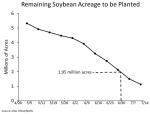COLUMBIA, Mo. – Tomatoes reign supreme as the No. 1 home garden vegetable for a reason.
“Our friend tomato is one of the easiest vegetables to grow,” said Tim Reinbott, superintendent at the University of Missouri Bradford Research Center.
Hundreds of tomato varieties crowd seed catalogues and gardening centers. Experimenting with new varieties can provide an adventure in taste, Reinbott said. “Celebrity, Big Boy or Better Boy varieties produce well for Missouri conditions, but heirlooms like Brandywine or the pink Mortgage Lifter can provide an excellent taste that’s worth a little lower yield,” he said. “There are such a wide variety of tastes and textures that we encourage you to experiment a little bit and share what you discover with your friends.”
Each fall, Reinbott holds the MU Tomato Fest, which attracts hundreds of people to sample and rank more than 130 varieties. He’s busy now planting those tomatoes to prepare for the next fest, Sept. 6, and said heirlooms often rank on top as a palate pleaser.
“We’re used to red tomatoes, but I like dark purple ones like Black Krim, and people more sensitive to acid content can go with yellow or orange tomatoes,” he said. “Many go to heirloom tomatoes that can have a richer, more tomatoey taste but often don’t offer quite the yield or disease resistance of new varieties.”
When caring for tomatoes, it’s important to consider soil health. Adding a little calcium can prevent blossom end rot, which is caused by a deficiency in that nutrient. Reinbott uses a liquid solution of fertilizer with 45 percent phosphorous, but said experienced gardeners know to reach for something found in many bathrooms.
“My father-in-law was a tomato guru and swore by putting a cup of Epsom salt with each one of the tomatoes he planted,” he said. “Epsom salt is essentially magnesium sulfate.” Magnesium and sulfur are two of the most essential elements for good photosynthesis, good fruit set and fruit quality.
“If you are using organic methods, you want to put some compost down by the root system, and, if not, a fertilizer high in phosphorous will bolster the root system,” he added.
When picking out plants, look for a healthy green color and seedlings that aren’t too leggy (long-stemmed). Even if the transplants are getting large, gardeners can just plant them a little deeper to ensure stability and health.
“Tomatoes that have gotten gangly in the greenhouse can and will root all along junctures on its stem,” Reinbott said. “All we have to do is break a few leaves off, open up our root ball and plant it a little deeper.”
Fungus is a major nemesis of tomato growers. Blights, which manifest as blotches and rust on lower leaves, are caused when dirt splashes onto the plant.
“Leaf blights like septoria start with those raindrops that splash, so we need to make sure we get a good mulch over newly planted tomatoes,” Reinbott said. “Whether it’s straw, newspaper or whatever you want to use, we need to protect our lower leaves and stems.”
Staking or caging plants is also a good call. This keeps the growing tomato upright to limit diseases like blight. However, stakes and cages can be havens for disease, so Reinbott suggests wiping them down with a 10 percent Clorox solution before using them.
Many gardeners also prune back “sucker” shoots, which are branches that tend to produce less fruit. Removing them will let more nutrients reach the remaining branches, causing a healthier plant and bigger fruit.
“If you have a larger tomato, it’s a good idea to prune off some of those side shoots, which leads to most of your yield being on the main stem and a better yield,” Reinbott said.
It’s still not too late to start tomatoes from seed.
“It only takes about six weeks from the time a tomato blooms until you have ripe fruit,” he said. “So if you plant before the end of May, you’ll have tomatoes on the Fourth of July. The nice thing about tomatoes is you can plant them well into June to stagger your tomato harvest all the way until frost.”
Find tomato tips and taste-testing results from the 2011 tomato festival at www.aes.missouri.edu/bradford/events/tomato-festival.php.
Read more http://extension.missouri.edu/news/DisplayStory.aspx?N=1427





